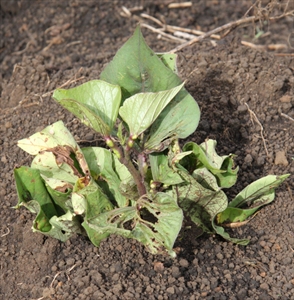Sweetpotato gall mite
Pacific Pests, Pathogens and Weeds - Online edition
Pacific Pests, Pathogens & Weeds
Sweetpotato gall mite (138)
Eriophyes gastrotrichus
South and Southeast Asia, Oceania. It has been reported from India (wild Ipomoea), Indonesia, the Philippines, and Papua New Guinea.
Sweetpotato, and weeds in the Convolvulaceae (morning glory family).
Irregular-shaped growths, known as galls, form on the stems, petioles and leaf blades (Photos 1&2). They vary in size from 2 to 10 mm in length, and 1 to 5 mm wide. It is thought that the galls develop when the mites inject a chemical into the plant as they feed.
The mites are too small to see with the naked eye. The adults are about 0.15 mm long and 0.05 mm wide, wormlike, white, cylindrical, becoming narrow towards the rear end (Figure). The body surface has numerous fine lines that give it a wrinkled look. Inside the galls, mites at all stages of development can be found. Eggs are laid in the leaves, stems, and petioles and hatch as nymphs, emerging as adults to infest new vines.
The mite is spread in galls on cuttings used for planting (Photo 3).
When there are heavy infestations of mites, and large numbers of galls on each shoot, the shoots become deformed. Trials in Indonesia, in 2011, compared growing plants from gall-free and gall-infected cutting and found that plants without galls had more storage roots (about 20%) and larger yields (about 15%).
Look for the characteristic galls on the vines. If a low power microscope is available cut the galls and examine for eggs, nymph and adults.
QUARANTINE
The unrestricted movement of plant propagating material (cuttings, shoots and storage roots) has the potential of further spreading the gall mite, and should be done with caution. Follow the advice given in FAO/IBPGR Technical Guidelines for the Safe Movement of Sweet Potato Germplasm (http://www.bioversityinternational.org/e-library/publications/detail/sweet-potato/).
CULTURAL CONTROL
Before planting:
- Do not plant vines with galls; use only gall-free planting material.
During growth:
- Inspect vines regularly and cut off and burn any shoots with galls.
- Destroy weeds within and around sweetpotato plantings, especially Ipomoea species in the Convolvulaceae family. Note, little is known about alternative hosts of this mite. In India, it has been recorded on Ipomoea staphylina.
- Destroy any sweetpotato plants that are growing wild outside the planted crops.
After harvest:
- Collect the vines after harvest and burn them.
RESISTANT VARIETIES
It is likely that there are differences between varieties in the number of galls and the damage done to the vines, but no research has been done to find out.
CHEMICAL CONTROL
Trials in Indonesia with dicofol applied weekly did not increase the yield of storage roots. Note, dicofol is an organochlorine miticide related to DDT, and its use is restricted in many countries. Abamectin, a product derived from a soil bacterium may give better results. It is absorbed into plants but is not systemic. Tests are needed to confirm its suitability against this mite.
____________________
When using a pesticide, always wear protective clothing and follow the instructions on the product label, such as dosage, timing of application, and pre-harvest interval. Recommendations will vary with the crop and system of cultivation. Expert advice on the most appropriate pesticide to use should always be sought from local agricultural authorities.
AUTHOR Grahame Jackson
Information (and Figure) from Amante V, et al. (2003). A field guide to the sweetpotato problems in the Philippines. The University of Queensland (https://www.soilwealth.com.au/imagesDB/news/Sweet-Potato-Pest-and-Disease-Guide.pdf); and from Ekman J, Lovatt J (2015) Pests, Diseases and Disorders of Sweetpotato: A Field Identification Guide. (https://www.soilwealth.com.au/imagesDB/news/Sweet-Potato-Pest-and-Disease-Guide.pdf).
Produced with support from the Australian Centre for International Agricultural Research under project PC/2010/090: Strengthening integrated crop management research in the Pacific Islands in support of sustainable intensification of high-value crop production, implemented by the University of Queensland and the Secretariat of the Pacific Community.







